Effect of Pit and Soil Types on Growth and Development, Nutrient Content and Fruit Quality of Pomegranate in the Central Deccan Plateau Region, India
Abstract
:1. Introduction
2. Material and Methods
2.1. Description of the Study Area
2.2. Establishment of the Pomegranate Orchard
2.3. Planting Techniques
2.4. Crop Husbandry
2.5. Collection, Processing, and Analysis of Samples
2.6. Statistical Analysis
3. Results
3.1. Basic Properties of Soil Types Used for Pomegranate Plantings in the Shallow and Gravelly Barren Land
3.2. Effect of Planting Techniques on Growth Parameters of Pomegranate Trees
3.3. Effect of Planting Techniques on Nutrient Content of Leaves of the Pomegranate Trees
3.4. Effect of Planting Techniques on Fruit Yield and Quality Parameters of Pomegranate
4. Discussion
4.1. Effectiveness of Planting Techniques on Growth and Development of Pomegranate Trees
4.2. Influence of Planting Pits and Soil Types on Leaf Nutrient Concentrations
4.3. Impact of Pit Size and Soil Types on Sustainable Fruit Production and Its Quality Parameters
4.4. Impact of Pit Volume and Spent Wash Application on Fruit Production
5. Conclusions
Supplementary Materials
Author Contributions
Funding
Institutional Review Board Statement
Informed Consent Statement
Data Availability Statement
Acknowledgments
Conflicts of Interest
References
- Saroj, P.L.; Kumar, R. Recent Advances in Pomegranate Production in India—A Review. Ann. Hortic. 2019, 12, 1–10. [Google Scholar] [CrossRef]
- Narayan, P.; Chand, S. Explaining Status and Scope of Pomegranate Production in India: An Economic Analysis. Int. Res. J. Agric. Econ. Stat. 2020, 11. [Google Scholar] [CrossRef]
- Marathe, R.A.; Sharma, J.; Dhinesh Babu, K. Identification of Suitable Soils for Cultivation of Pomegranate (Punica Granatum) Cv Ganesh. Indian J. Agric. Sci. 2016, 86, 227–233. [Google Scholar] [CrossRef]
- Kheoruenromne, I.; Suddhiprakarn, A.; Watana, S. Properties and Agricultural Potential of Skeletal Soils in Southern Thailand. Agric. Nat. Resour. 2000, 34, 52–63. [Google Scholar]
- Devin, S.R.; Prudencio, Á.S.; Mahdavi, S.M.E.; Rubio, M.; Martínez-García, P.J.; Martínez-Gómez, P. Orchard Management and Incorporation of Biochemical and Molecular Strategies for Improving Drought Tolerance in Fruit Tree Crops. Plants 2023, 12, 773. [Google Scholar] [CrossRef] [PubMed]
- Fulkey, G.; Nooman, H.J. Effects ff Soil Volume on Root Growth and Nutrient Uptake. Dev. Agric. Manag. For. Ecol. 1991, 24, 446–448. [Google Scholar]
- Ojasvi, P.R.; Goyal, R.K.; Gupta, J.P. The Micro-Catchment Water Harvesting Technique for the Plantation of Jujube (Zizyphus Mauritiana) in an Agroforestry System under Arid Conditions. Agric. Water Manag. 1999, 41, 139–147. [Google Scholar] [CrossRef]
- Mauki, D.; Kilonzo, M. Planting Pit Size Determines Successful Tree Seedling Establishment in Arid and Semi-Arid Region of Tanzania. Environ. Sustain. Indic. 2022, 15, 100197. [Google Scholar] [CrossRef]
- Celma, S.; Blate, K.; Lazdiņa, D.; Dūmiņš, K.; Neimane, S.; Štāls, T.A.; Štikāne, K. Effect of Soil Preparation Method on Root Development of P. Sylvestris and P. Abies Saplings in Commercial Forest Stands. New For. 2019, 50, 283–290. [Google Scholar] [CrossRef]
- Von Carlowitz, P.G.; Wolf, G.V. Open-Pit Sunken Planting: A Tree Establishment Technique for Dry Environments. Agrofor. Syst. 1991, 15, 17–29. [Google Scholar] [CrossRef]
- Jo, H.K.; Park, H.M. Effects of Pit Plantings on Tree Growth in Semi-Arid Environments. For. Sci. Technol. 2017, 13, 66–70. [Google Scholar] [CrossRef]
- Mohammad, N.; Rajkumar, M.; Singh, K.; Nain, N.P.S.; Singh, S.; Rao, G.R.; Prakasham, U. Spacing, PIT Size and Irrigation Influence Early Growth Performances of Forest Tree Species. J. Trop. For. Sci. 2021, 33, 69–76. [Google Scholar] [CrossRef]
- Cardoso, F.C.G.; Marques, R.; Botosso, P.C.; Marques, M.C.M. Stem Growth and Phenology of Two Tropical Trees in Contrasting Soil Conditions. Plant Soil 2012, 354, 269–281. [Google Scholar] [CrossRef]
- Sun, H.; Huang, X.; Chen, T.; Zhou, P.; Huang, X.; Jin, W.; Liu, D.; Zhang, H.; Zhou, J.; Wang, Z.; et al. Fruit Quality Prediction Based on Soil Mineral Element Content in Peach Orchard. Food Sci. Nutr. 2022, 10, 1756–1767. [Google Scholar] [CrossRef] [PubMed]
- Kumar, G.; Sharma, D.D.; Kuchay, M.A.; Kumar, R.; Singh, G.; Kaushal, B. Effect of Foliar Application of Nutrients on Growth, Yield and Fruit Quality of Pomegranate (Punica Granatum L.) Cv. Bhagwa. Curr. J. Appl. Sci. Technol. 2020, 39, 50–57. [Google Scholar] [CrossRef]
- Marathe, R.A.; Sharma, J.; Murkute, A.A. Innovative Soil Management for Sustainable Pomegranate Cultivation on Skeletal Soils. Soil Use Manag. 2018, 34, 258–265. [Google Scholar] [CrossRef]
- Nadeem Shah, M.; Wright, D.L.; Hussain, S.; Koutroubas, S.D.; Seepaul, R.; George, S.; Ali, S.; Naveed, M.; Khan, M.; Tanveer Altaf, M.; et al. Organic Fertilizer Sources Improve the Yield and Quality Attributes of Maize (Zea Mays L.) Hybrids by Improving Soil Properties and Nutrient Uptake under Drought Stress. J. King Saud Univ. Sci. 2023, 35, 102570. [Google Scholar] [CrossRef]
- Singh, R.; Potekar, S.; Chaudhary, A.; Das, D.; Rane, J.; Pathak, H. Climatic Trends in Western Maharashtra, India; National Institute of Abiotic Stress Management: Pune, India, 2020. [Google Scholar]
- Chandra, R.; Suroshe, S.; Sharma, J.; Sharma, J.; Marathe, R.A.; Meshram, D.T. Pomegranate Growing Manual; Indian Council of Agricultural Research: Solapur, India, 2011. [Google Scholar]
- Bouyoucos, G.J. Hydrometer Method Improved for Making Particle Size Analyses of Soils 1. Agron. J. 1962, 54, 464–465. [Google Scholar] [CrossRef]
- Vincent, K.R.; Chadwick, O.A. Synthesizing Bulk Density for Soils with Abundant Rock Fragments. Soil Sci. Soc. Am. J. 1994, 58, 455–464. [Google Scholar] [CrossRef]
- Reichert, J.M.; Albuquerque, J.A.; Kaiser, D.R.; Reinert, D.J.; Urach, F.L.; Carlesso, R. Estimation of Water Retention and Availability in Soils of Rio Grande Do Sul. Rev. Bras. Cienc. Solo 2009, 33, 1547–1560. [Google Scholar] [CrossRef]
- Corey, R.B. A Textbook of Soil Chemical Analysis. Soil Sci. Soc. Am. J. 1973, 37, 520. [Google Scholar] [CrossRef]
- Walkley, A.J.; Black, I.A. Estimation of Soil Organic Carbon by the Chromic Acid Titration Method. Soil Sci. 1934, 37, 29–38. [Google Scholar] [CrossRef]
- Hussain, F.; Malik, K.A. Evaluation of Alkaline Permanganate Method and Its Modification as an Index of Soil Nitrogen Availability. Plant Soil 1985, 84, 279–282. [Google Scholar] [CrossRef]
- Olsen, S.R.; Cole, C.V.; Watanabe, F.S. Estimation of Available Phosphorus in Soils by Extraction with Sodium Bicarbonate; US Government Printing Office: Washington, DC, USA, 1954; Volume 939. [Google Scholar]
- Williams, C.H.; Steinbergs, A. Soil Sulphur Fractions as Chemical Indices of Available Sulphur in Some Australian Soils. Aust. J. Agric. Res. 1959, 10, 340–352. [Google Scholar] [CrossRef]
- McHale, M.R.; Burke, I.C.; Lefsky, M.A.; Peper, P.J.; McPherson, E.G. Urban Forest Biomass Estimates: Is It Important to Use Allometric Relationships Developed Specifically for Urban Trees? Urban Ecosyst. 2009, 12, 95–113. [Google Scholar] [CrossRef]
- Marini, R.P.; Barden, J.A.; Sowers, D. Growth and Fruiting Responses of ‘Redchief Delicious’ Apple Trees to Heading Cuts and Scaffold Limb Removal. J. Am. Soc. Hortic. Sci. 2019, 118, 446. [Google Scholar] [CrossRef]
- Levillain, J.; Thongo M’Bou, A.; Deleporte, P.; Saint-André, L.; Jourdan, C. Is the Simple Auger Coring Method Reliable for Below-Ground Standing Biomass Estimation in Eucalyptus Forest Plantations? Ann. Bot. 2011, 108, 221–230. [Google Scholar] [CrossRef] [PubMed]
- Sochacki, S.J.; Ritson, P.; Brand, B.; Harper, R.J.; Dell, B. Accuracy of Tree Root Biomass Sampling Methodologies for Carbon Mitigation Projects. Ecol. Eng. 2017, 98, 264–274. [Google Scholar] [CrossRef]
- Habib, R. Total Root Length as Estimated from Small Sub-Samples. Plant Soil 1988, 108, 267–274. [Google Scholar] [CrossRef]
- Pierret, A.; Moran, C.J.; Mclachlan, C.B.; Kirby, J.M. Measurement of Root Length Density in Intact Samples Using X-Radiography and Image Analysis. Image Anal. Stereol. 2000, 19, 145–149. [Google Scholar] [CrossRef]
- Tandon, H.L.S. Methods of Analysis of Soils, Plants, Waters, Fertilisers & Organic Manures; CABI: New Delhi, India, 2005. [Google Scholar]
- Rahman, M.A.; Stringer, P.; Ennos, A.R. Effect of Pit Design and Soil Composition on Performance of Pyrus Calleryana Street Trees in the Establishment Period. Arboric. Urban For. 2013, 39, 256–266. [Google Scholar] [CrossRef]
- Proebsting, L.; Jerie, P.H.; Irvine, J. Water Deficits and Rooting Volume Modify Peach Tree Growth and Water Relations. J. Am. Soc. Hortic. Sci. 2022, 114, 368–372. [Google Scholar] [CrossRef]
- Ding, H.; Xue, L.; Liu, H.; Li, L.; Wang, H.; Zhai, M. Influence of Root Volume, Plant Spacing, and Planting Pattern of Tap-like Tree Root System on Slope Protection Effect. Forests 2022, 13, 1925. [Google Scholar] [CrossRef]
- Ewetola, E.A.; Oyeyiola, Y.B.; Owoade, F.M.; Farotimi, M.F. Influence of Soil Texture and Compost on the Early Growth and Nutrient Uptake of Moringa Oleifera Lam. Acta Fytotech. Et Zootech. 2019, 22, 26–33. [Google Scholar] [CrossRef]
- Ahmed, K.; Mannan, A. Effect of Size of Pit and Spacing on the Performance of Amritsagar Banana. Punjab Fruit J. 1970, 32, 713. [Google Scholar]
- de Oliveira, V.P.; Martins, W.B.R.; Rodrigues, J.I.d.M.; Silva, A.R.; Lopes, J.d.C.A.; de Lima Neto, J.F.; Schwartz, G. Are Liming and Pit Size Determining for Tree Species Establishment in Degraded Areas by Kaolin Mining? Ecol. Eng. 2022, 178, 106599. [Google Scholar] [CrossRef]
- Ouma, G. Growth Responses of ‘Rough Lemon’ (Citrus Limon L.) Rootstock Seedlings to Different Container Sizes and Nitrogen Levels. Agric. Trop. Et Subtrop. 2006, 39, 183–188. [Google Scholar]
- Isaac, M.E.; Borden, K.A. Nutrient Acquisition Strategies in Agroforestry Systems. Plant Soil 2019, 444, 664. [Google Scholar] [CrossRef]
- Newman, E.I.; Andrews, R.E. Uptake of Phosphorus and Potassium in Relation to Root Growth and Root Density. Plant Soil 1973, 38, 49–69. [Google Scholar] [CrossRef]
- Dumroese, R.K.; Sung, S.J.S.; Pinto, J.R.; Ross-Davis, A.; Scott, D.A. Morphology, Gas Exchange, and Chlorophyll Content of Longleaf Pine Seedlings in Response to Rooting Volume, Copper Root Pruning, and Nitrogen Supply in a Container Nursery. New For. 2013, 44, 881–897. [Google Scholar] [CrossRef]
- Baitelle, D.; Baroni, D.; Vieira, K.; Freitas, S.; Meneghelli, C.; Berilli, S.; Haddade, I.; Verdin-Filho, A. Pit Dimensions in the Early Development of Conilon Coffee Propagated by Seeds and Cuttings. J. Exp. Agric. Int. 2018, 20, 1–8. [Google Scholar] [CrossRef]
- Conforth, I.S. Relationships between Soil Volume used by Roots and Nutrient Accessibility. J. Soil Sci. 1968, 19, 291–301. [Google Scholar] [CrossRef]
- Vadivel, R.; Singh, Y.; Bal, S.; Rane, J.; Singh, N.P. Sharing Information for “Napier Grass: A Model Crop for Developing Partially Weathered Gravelly Land in the Central Deccan Plateau Region”. Proc. Natl. Acad. Sci. India Sect. B Biol. Sci. 2018, 89, 180723. [Google Scholar] [CrossRef]
- Sainju, U.M.; Liptzin, D.; Jabro, J.D. Relating Soil Physical Properties to Other Soil Properties and Crop Yields. Sci. Rep. 2022, 12, 22025. [Google Scholar] [CrossRef] [PubMed]
- Bravo, K.; Toselli, M.; Baldi, E.; Marcolini, G.; Sorrenti, G.; Quartieri, M.; Marangoni, B. Effect of Organic Fertilization on Carbon Assimilation and Partitioning in Bearing Nectarine Trees. Sci. Hortic. 2012, 137, 100–106. [Google Scholar] [CrossRef]
- Li, B.; Wang, J.; Ren, X.; Bao, L.; Zhang, L.; Zhang, L.; Han, M.; Zhang, D. Root Growth, Yield and Fruit Quality of “Red Fuji” Apple Trees in Relation to Planting Depth of Dwarfing Interstock on the Loess Plateau. Eur. J. Hortic. Sci. 2015, 80, 109–116. [Google Scholar] [CrossRef]
- Guo, K.; Guo, Z.; Guo, Y.; Qiao, G. The Effects of Soil Nutrient on Fruit Quality of ‘Hayward’ Kiwifruit (Actinidia Chinensis) in Northwest China. Eur. J. Hortic. Sci. 2020, 85, 471–476. [Google Scholar] [CrossRef]
- Rato, A.E.; Agulheiro, A.C.; Barroso, J.M.; Riquelme, F. Soil and Rootstock Influence on Fruit Quality of Plums (Prunus Domestica L.). Sci. Hortic. 2008, 118, 218–222. [Google Scholar] [CrossRef]
- Loh, F.C.W.; Grabosky, J.C.; Bassuk, N.L. Growth Response of Ficus Benjamina to Limited Soil Volume and Soil Dilution in a Skeletal Soil Container Study. Urban For. Urban Green. 2003, 2, 53–62. [Google Scholar] [CrossRef]
- Lu, J.; Shao, G.; Gao, Y.; Zhang, K.; Wei, Q.; Cheng, J. Effects of Water Deficit Combined with Soil Texture, Soil Bulk Density and Tomato Variety on Tomato Fruit Quality: A Meta-Analysis. Agric. Water Manag. 2021, 243, 106427. [Google Scholar] [CrossRef]
- Rajagopal, V.; Paramjit, S.M.; Suresh, K.P.; Yogeswar, S.; Nageshwar, R.D.V.K.; Avinash, N. Significance of Vinasses Waste Management in Agriculture and Environmental Quality—Review. Afr. J. Agric. Res. 2014, 9, 2862–2873. [Google Scholar] [CrossRef]
- Alburquerque, J.A.; de la Fuente, C.; Campoy, M.; Carrasco, L.; Nájera, I.; Baixauli, C.; Caravaca, F.; Roldán, A.; Cegarra, J.; Bernal, M.P. Agricultural Use of Digestate for Horticultural Crop Production and Improvement of Soil Properties. Eur. J. Agron. 2012, 43, 119–128. [Google Scholar] [CrossRef]

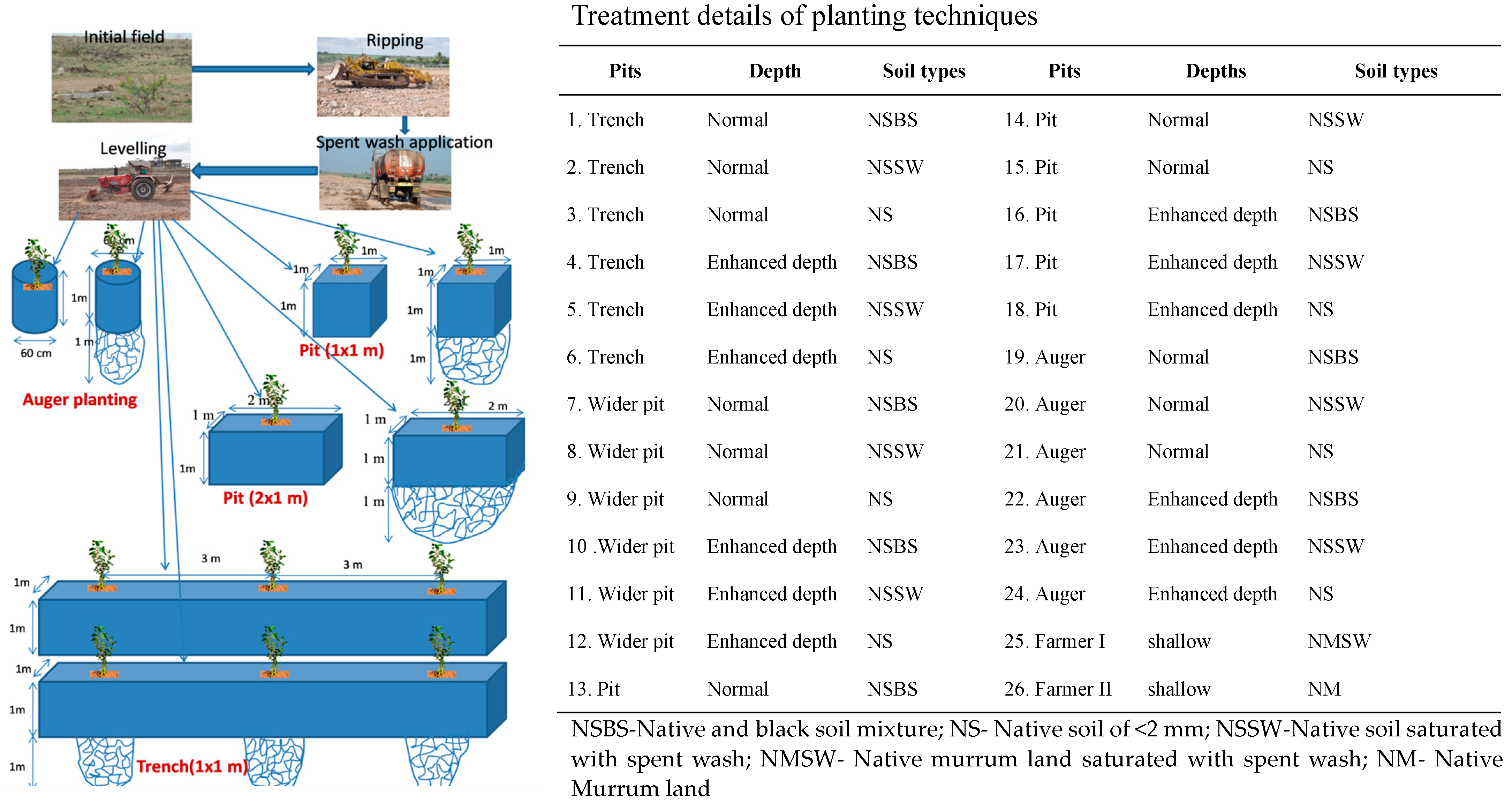

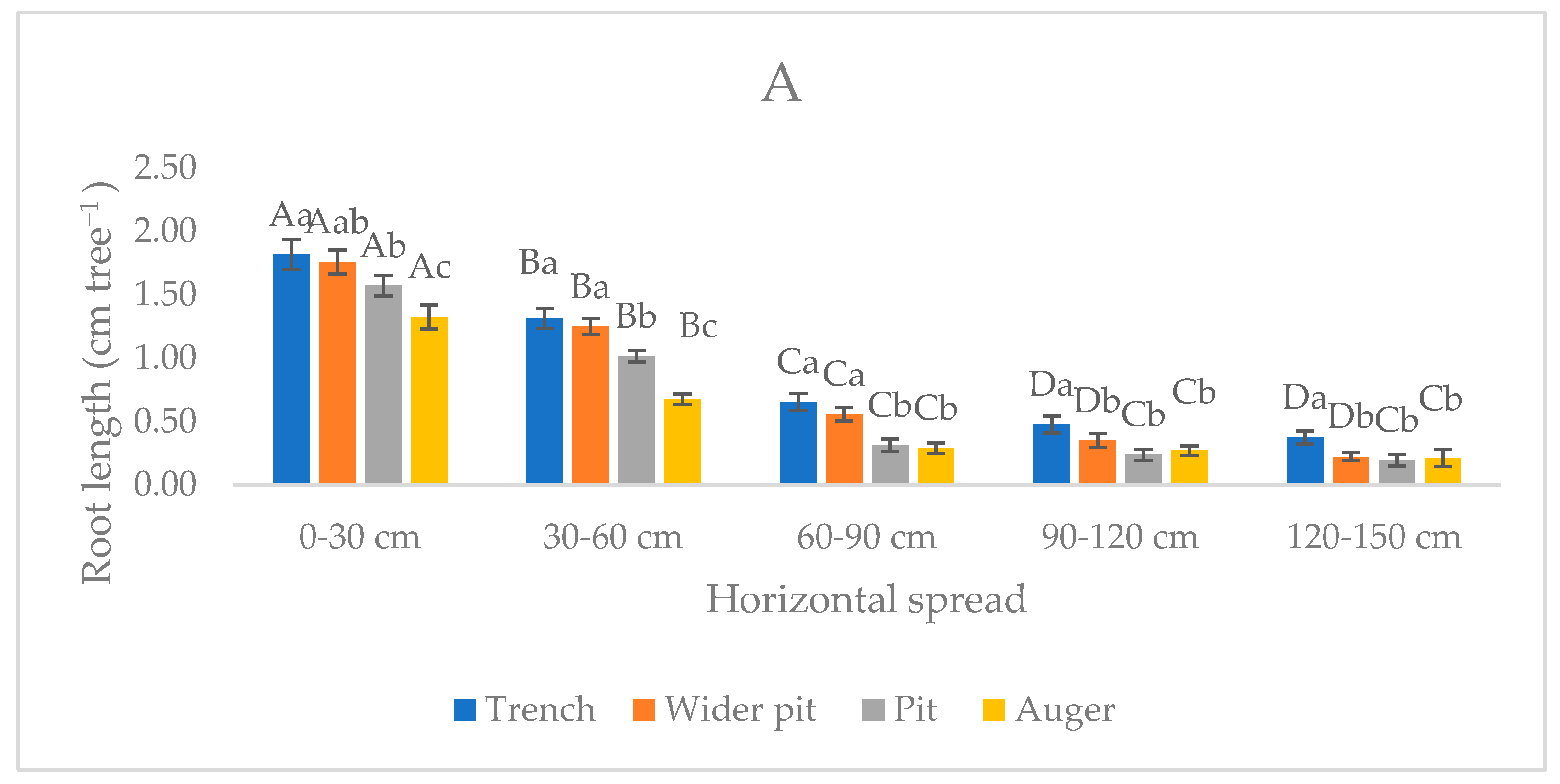
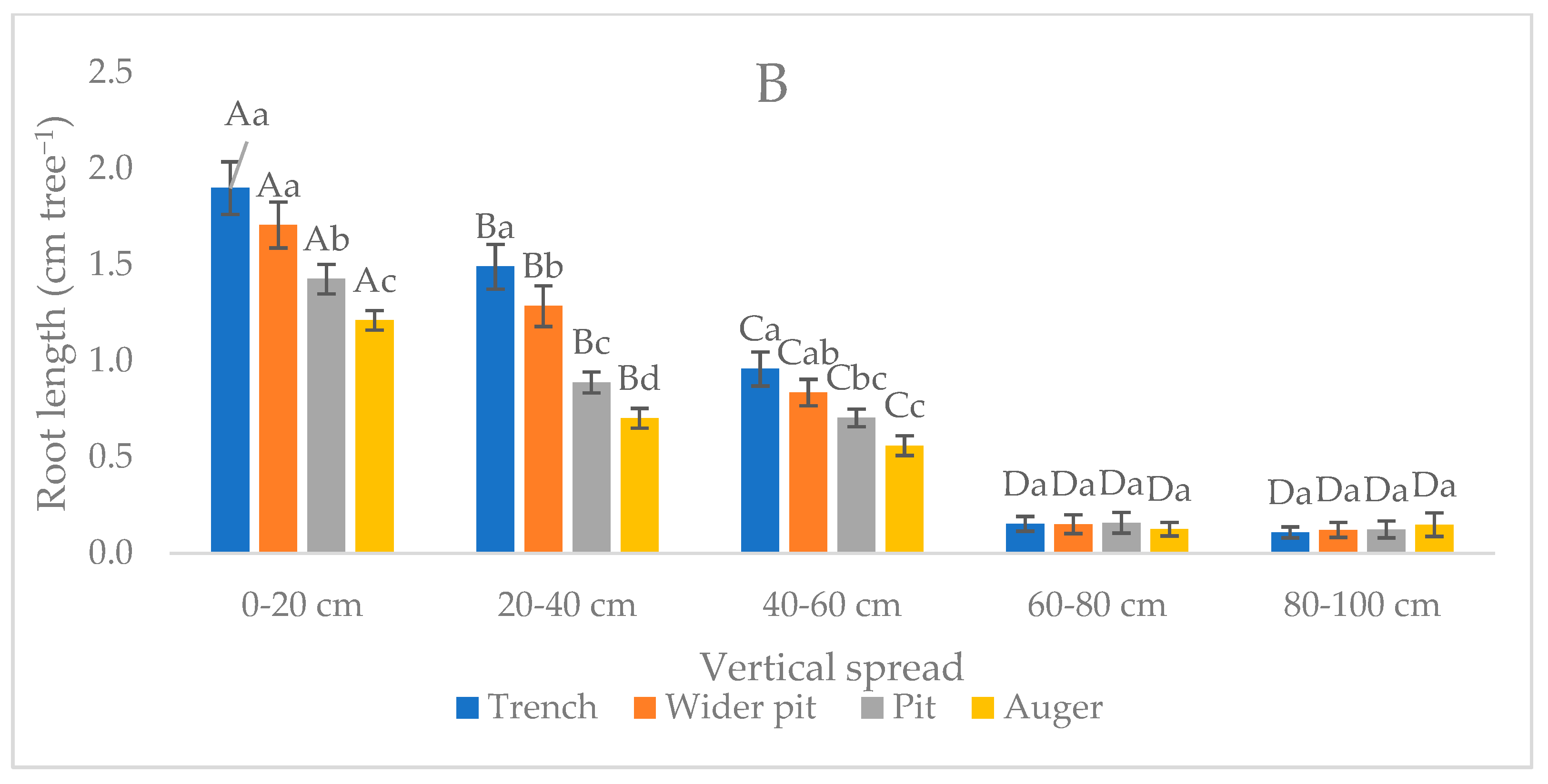
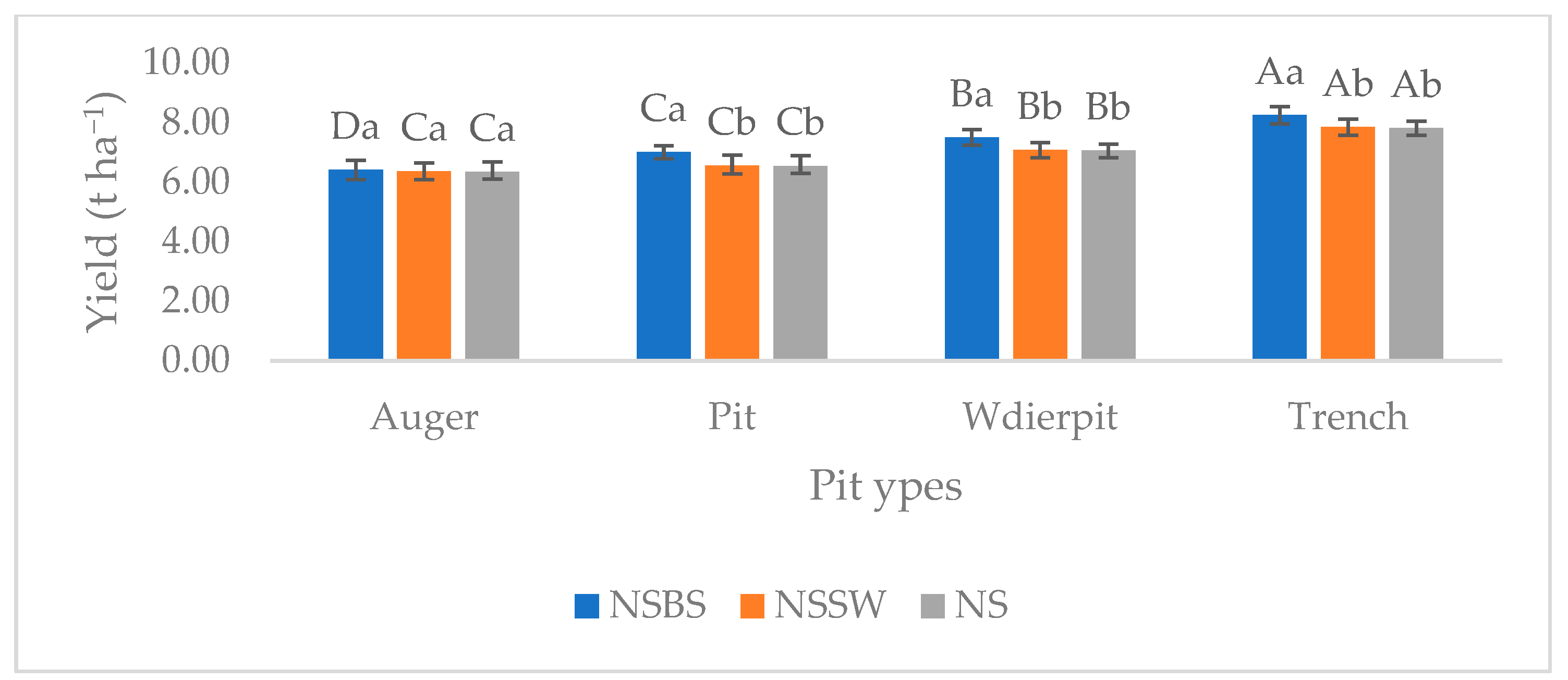
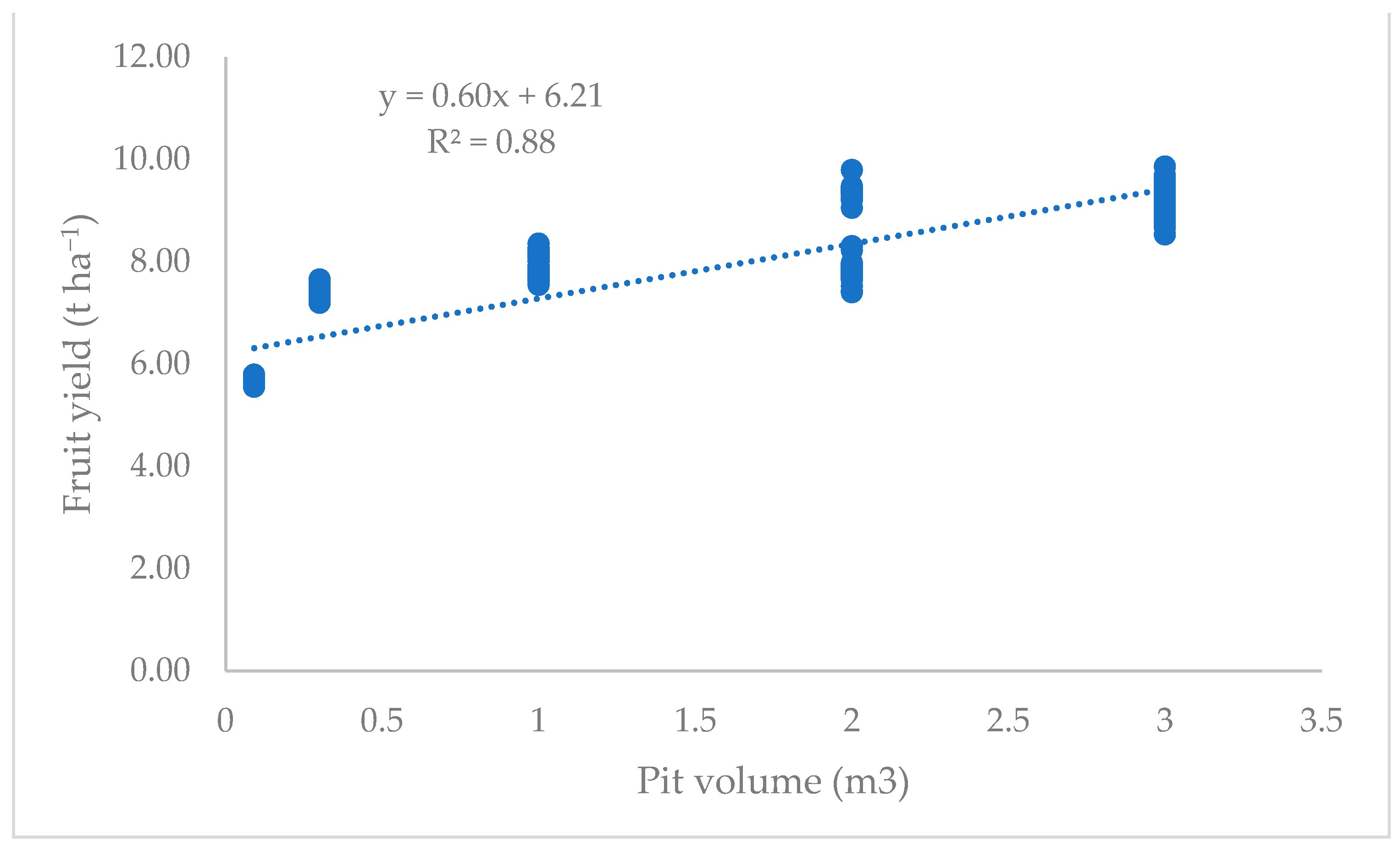
| Treat No | Pits | Soil Types | CF (%) | Sand (%) | Silt (%) | Clay (%) | SSV (m3 Mg−1) | PAW (%) | pH (1:2) | EC (1:2) (dS m−1) | SOC (%) | N (kg ha−1) | P (kg ha−1) | K (kg ha−1) |
|---|---|---|---|---|---|---|---|---|---|---|---|---|---|---|
| T1 | Trench | NSBS | 15.6 | 42.5 | 25.2 | 32.3 | 0.73 | 17.5 | 7.4 | 0.45 | 0.42 | 154.5 | 8.5 | 225.2 |
| T2 | Trench | NSSW | 20.5 | 62.5 | 19.6 | 17.9 | 0.63 | 11.5 | 4.6 | 0.27 | 0.34 | 135.5 | 3.8 | 223.2 |
| T3 | Trench | NS | 21.2 | 64.1 | 19.2 | 16.7 | 0.65 | 12.3 | 6.7 | 0.25 | 0.30 | 132.5 | 3.5 | 216.2 |
| T4 | Trench with ED | NSBS | 15.2 | 38.3 | 26.5 | 35.2 | 0.68 | 18.2 | 7.2 | 0.42 | 0.43 | 156.0 | 8.2 | 220.5 |
| T5 | Trench with ED | NSSW | 19.8 | 70.6 | 15.1 | 14.3 | 0.65 | 12.6 | 4.7 | 0.29 | 0.32 | 137.5 | 4.0 | 217.3 |
| T6 | Trench with ED | NS | 20.2 | 71.2 | 14.3 | 14.5 | 0.64 | 11.8 | 6.6 | 0.25 | 0.28 | 135.2 | 3.7 | 218.5 |
| T7 | Wider pit | NSBS | 15.1 | 40.6 | 26.0 | 33.4 | 0.69 | 17.5 | 7.3 | 0.40 | 0.42 | 158.0 | 8.0 | 219.3 |
| T8 | Wider pit | NSSW | 21.8 | 63.1 | 19.0 | 17.9 | 0.66 | 12.5 | 5.2 | 0.27 | 0.32 | 132.5 | 4.1 | 217.6 |
| T9 | Wider pit | NS | 20.8 | 63.8 | 17.8 | 18.4 | 0.65 | 11.8 | 6.7 | 0.29 | 0.28 | 134.1 | 3.9 | 217.2 |
| T10 | Wider Pit with ED | NSBS | 21.2 | 38.5 | 25.5 | 36.0 | 0.70 | 17.3 | 7.5 | 0.43 | 0.45 | 155.0 | 8.3 | 223.2 |
| T11 | Wider Pit with ED | NSSW | 20.5 | 65.2 | 18.5 | 16.3 | 0.65 | 11.8 | 4.7 | 0.35 | 0.30 | 136.2 | 4.2 | 220.2 |
| T12 | Wider Pit with ED | NS | 21 | 66.0 | 17.2 | 16.8 | 0.64 | 12.4 | 6.9 | 0.32 | 0.27 | 135.4 | 3.8 | 218.2 |
| T13 | Pit | NSBS | 14.8 | 34.2 | 30.2 | 35.6 | 0.71 | 18.5 | 7.5 | 0.42 | 0.43 | 153.0 | 8.1 | 223.5 |
| T14 | Pit | NSSW | 21.3 | 64.0 | 18.2 | 17.8 | 0.64 | 11.5 | 4.8 | 0.27 | 0.30 | 134.5 | 4.3 | 223.2 |
| 15 | Pit | NS | 20.7 | 70.2 | 14.5 | 15.3 | 0.66 | 12.6 | 7.0 | 0.30 | 0.26 | 133.5 | 3.7 | 221.5 |
| T16 | Pit with ED | NSBS | 15.9 | 39.2 | 25.8 | 34.7 | 0.69 | 18.2 | 7.3 | 0.28 | 0.44 | 155.0 | 8.4 | 220.5 |
| T17 | Pit with ED | NSSW | 20.2 | 65.0 | 18.6 | 16.4 | 0.65 | 12.3 | 4.3 | 0.35 | 0.32 | 136.5 | 4.0 | 215.6 |
| T18 | Pit with ED | NS | 20.8 | 65.4 | 18.8 | 15.8 | 0.64 | 11.7 | 6.9 | 0.25 | 0.25 | 132.5 | 3.6 | 214.5 |
| T19 | Auger | NSBS | 16.3 | 37.2 | 26.0 | 36.8 | 0.70 | 17.8 | 7.4 | 0.42 | 0.43 | 157.0 | 8.3 | 221.5 |
| T20 | Auger | NSSW | 19.8 | 64.5 | 19.5 | 16.0 | 0.63 | 11.5 | 4.0 | 0.27 | 0.36 | 135.2 | 4.1 | 219.2 |
| T21 | Auger | NS | 21.2 | 65.0 | 19.1 | 15.9 | 0.64 | 12.2 | 6.9 | 0.29 | 0.28 | 132.2 | 3.9 | 218.6 |
| T22 | Auger with ED | NSBS | 15.5 | 40.0 | 25.7 | 34.3 | 0.67 | 17.6 | 7.7 | 0.43 | 0.42 | 156.0 | 8.6 | 223.5 |
| T23 | Auger with ED | NSSW | 20.5 | 66.2 | 17.8 | 16.0 | 0.63 | 12.0 | 3.8 | 0.26 | 0.32 | 137.5 | 3.5 | 220.1 |
| T24 | Auger with ED | NS | 21 | 65.1 | 18.5 | 15.4 | 0.65 | 11.8 | 6.9 | 0.35 | 0.26 | 134.6 | 3.7 | 219.6 |
| T25 | Farmer Practice II | NMSW | 72.5 | 75.2 | 12.5 | 12.3 | 0.63 | 11.0 | 7.5 | 0.30 | 0.27 | 131.0 | 3.3 | 192.5 |
| T26 | Farmer Practice I | NM | 74.3 | 76.3 | 13.8 | 9.9 | 0.65 | 10.9 | 7.7 | 0.35 | 0.25 | 130.0 | 3.1 | 193.6 |
| Source | Pits | Soil | Depth | Pits × Soil | Pits × Depth | Soil × Depth | Pits × Soil × Depth |
|---|---|---|---|---|---|---|---|
| AGB (kg tree−1) | 0.00 | 0.00 | 0.79 | 0.81 | 0.32 | 0.11 | 0.58 |
| Crown spread (m2) | 0.00 | 0.00 | 0.23 | 0.55 | 0.51 | 0.98 | 0.90 |
| Root biomass (kg tree−1) | 0.00 | 0.00 | 0.08 | 0.000 | 0.41 | 0.98 | 0.30 |
| Root length (m) | 0.00 | 0.00 | 0.18 | 0.421 | 1.0 | 0.9 | 1.00 |
| RLD (m3 m−3) | 0.00 | 0.00 | 0.70 | 0.650 | 0.99 | 0.18 | 1.00 |
| Nitrogen (%) | 0.00 | 0.00 | 0.16 | 0.360 | 0.72 | 0.62 | 1.00 |
| Phosphorous (%) | 0.00 | 0.00 | 0.68 | 0.680 | 0.97 | 0.19 | 0.72 |
| Potassium (%) | 0.00 | 0.26 | 0.67 | 0.741 | 0.96 | 0.81 | 0.97 |
| Fruit length (mm) | 0.000 | 0.000 | 0.810 | 0.920 | 1.000 | 0.550 | 0.920 |
| Fruit width (mm) | 0.000 | 0.000 | 0.054 | 0.078 | 0.800 | 0.933 | 0.924 |
| Juice content (%) | 0.000 | 0.000 | 0.200 | 0.065 | 0.129 | 0.411 | 0.662 |
| Total soluble solids (o) | 0.000 | 0.000 | 0.452 | 0.091 | 0.633 | 0.345 | 0.281 |
| Treatments | Growth Parameters | Nutrient Content of Leaf | ||||||
|---|---|---|---|---|---|---|---|---|
| AGB (kg tree−1) | Crown Spread (m2) | Root Biomass (kg tree−1) | Root Length (m tree−1) | RLD (cm cm−3) | N (%) | P (%) | K (%) | |
| Pits | ||||||||
| 1. Trench | 70.6 ± 2.8 a | 3.31 ± 0.47 a | 24.8 ± 2.4 a | 4.6 ± 0.59 a | 0.09 ± 0.01 a | 1.58 ± 0.10 a | 0.28 ± 0.05 a | 1.78 ± 0.08 a |
| 2.Wider pit | 70.3 ± 3.1 a | 3.30 ± 0.40 a | 24.4 ± 1.5 a | 4.1 ± 0.59 b | 0.12 ± 0.01 a | 1.56 ± 0.09 a | 0.22 ± 0.04 b | 1.55 ± 0.07 b |
| 3. Pit | 65.7 ± 2.6 b | 2.27 ± 0.33 b | 24.0 ± 2.0 b | 3.3 ± 0.56 c | 0.20 ± 0.02 b | 1.39 ± 0.07 b | 0.16 ± 0.03 c | 1.30 ± 0.06 c |
| 4. Auger | 62.1 ± 2.5 c | 2.19 ± 0.29 b | 16.6 ± 1.0 c | 2.8 ± 0.48 d | 0.21 ± 0.02 c | 1.24 ± 0.07 c | 0.12 ± 0.03 d | 1.29 ± 0.06 d |
| Soil types | ||||||||
| 1. NSBS | 70.3 ± 4.8 a | 2.91 ± 0.67 a | 23.6 ± 4.5 a | 3.9 ± 0.48 a | 0.15 ± 0.03 a | 1.48 ± 0.17 a | 0.21 ± 0.08 a | 1.49 ± 0.23 a |
| 2. NSSW | 66.9 ± 4.7 b | 2.71 ± 0.64 b | 21.0 ± 3.1 b | 3.6 ± 0.46 b | 0.23 ± 0.02 b | 1.43 ± 0.16 b | 0.19 ± 0.06 b | 1.47 ± 0.20 a |
| 3. NS | 66.0 ± 4.3 c | 2.69 ± 0.62 b | 20.5 ± 3.2 b | 3.6 ± 0.40 b | 0.25 ± 0.02 b | 1.44 ± 0.15 b | 0.19 ± 0.05 b | 1.48 ± 0.19 a |
| Farmers method—II | 38.0 ± 2.0 | 1.50 ± 0.21 | 14.0 ± 0.20 | 2.6 ± 0.52 | 0.52 ± 0.01 | 1.16 ± 0.10 | 0.18 ± 0.03 | 1.20 ± 0.07 |
| Farmers method—I | 37.5 ± 2.3 | 1.70 ± 0.23 | 13.0 ± 2.1 | 2.5 ± 0.56 | 0.56 ± 0.01 | 1.15 ± 0.09 | 0.17 ± 0.03 | 1.23 ± 0.09 |
| Treatments | Yield (t ha−1) | Treatments | Yield (t ha−1) |
|---|---|---|---|
| Pit types | Time (Years) | ||
| Auger | 6.37 ± 1.03 d | 4th | 5.71 ± 0.43 d |
| Pit | 6.70 ± 0.98 c | 5th | 6.26 ± 0.73 c |
| Wider pit | 7.21 ± 1.09 b | 6th | 7.01 ± 0.45 b |
| Trench | 7.97 ± 1.17 a | 7th | 8.15 ± 0.79 a |
| Soil types | 8th | 8.18 ± 0.4 a | |
| NS | 6.94 ± 1.19 b | Farmer—II | 5.20 ± 0.70 |
| NSSW | 6.96 ± 1.20 b | Farmer—I | 5.16 ± 0.73 |
| NSBS | 7.29 ± 1.26 a | ||
| Treatments | Fruit Length (mm) | Fruit Width (mm) | Fruit Juice Content (%) | TSS (°Brix) |
|---|---|---|---|---|
| Pit types | ||||
| 1.Trench | 65.0 ± 4.97 a | 63.52 ± 5.21 a | 48.5 ± 4.06 a | 16.05 ± 1.62 a |
| 2.Wider pit | 64.9 ± 5.04 a | 63.39 ± 4.35 a | 45.0 ± 3.25 b | 15.70 ± 1.05 ab |
| 3. Pit | 59.6 ± 3.91 b | 60.41 ± 2.27 b | 42.2 ± 2.75 c | 14.70 ± 0.83 b |
| 4. Auger | 56.0 ± 2.70 b | 50.01 ± 3.25 b | 38.7 ± 2.16 d | 13.90 ± 1.01 b |
| Soil types | ||||
| 1. NSBS | 61.7 ± 3.90 a | 61.76 ± 2.71 a | 45.5 ± 2.05 a | 15.4 ± 1.18 a |
| 2. NSSW | 53.3 ± 3.04 b | 56.26 ± 2.43 b | 43.3 ± 2.12 b | 13.6 ± 0.78 b |
| 3. NS | 51.1 ± 4.93 b | 55.12 ± 2.36 b | 42.9 ± 2.01 c | 13.2 ± 0.81 b |
| Farmers method—II | 46.5 ± 3.52 | 53.2 ± 1.05 | 35.0 ± 2.50 | 11.9 ± 1.70 |
| Farmers method—I | 44.8 ± 4.70 | 52.7 ± 1.02 | 34.4 ± 2.10 | 11.5 ± 1.60 |
Disclaimer/Publisher’s Note: The statements, opinions and data contained in all publications are solely those of the individual author(s) and contributor(s) and not of MDPI and/or the editor(s). MDPI and/or the editor(s) disclaim responsibility for any injury to people or property resulting from any ideas, methods, instructions or products referred to in the content. |
© 2024 by the authors. Licensee MDPI, Basel, Switzerland. This article is an open access article distributed under the terms and conditions of the Creative Commons Attribution (CC BY) license (https://creativecommons.org/licenses/by/4.0/).
Share and Cite
Vadivel, R.; Reddy, K.S.; Singh, Y.; Nangare, D.D. Effect of Pit and Soil Types on Growth and Development, Nutrient Content and Fruit Quality of Pomegranate in the Central Deccan Plateau Region, India. Sustainability 2024, 16, 8099. https://doi.org/10.3390/su16188099
Vadivel R, Reddy KS, Singh Y, Nangare DD. Effect of Pit and Soil Types on Growth and Development, Nutrient Content and Fruit Quality of Pomegranate in the Central Deccan Plateau Region, India. Sustainability. 2024; 16(18):8099. https://doi.org/10.3390/su16188099
Chicago/Turabian StyleVadivel, Rajagopal, Kotha Sammi Reddy, Yogeshwar Singh, and Dhananjay D. Nangare. 2024. "Effect of Pit and Soil Types on Growth and Development, Nutrient Content and Fruit Quality of Pomegranate in the Central Deccan Plateau Region, India" Sustainability 16, no. 18: 8099. https://doi.org/10.3390/su16188099






